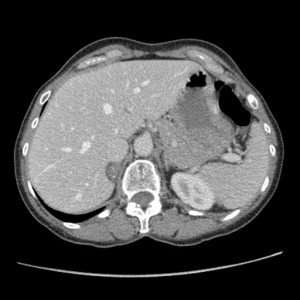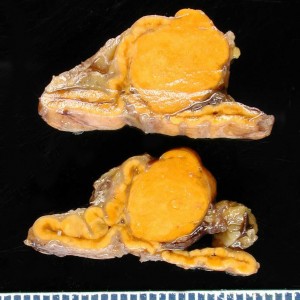Have you lost a lot of weight lately and also experiencing pain in the back and abdomen? Watch out, for these are classic symptoms of an Adrenal Adenoma. Read and learn all the causes, symptoms and possible treatments of this tumor.
Adrenal Adenoma Definition
Page Contents
- 1 Adrenal Adenoma Definition
- 2 Adrenal Adenoma Types
- 3 Adrenal Adenoma Incidence
- 4 Adrenal Adenoma Causes
- 5 Adrenal Adenoma Risk Factors
- 6 Adrenal Adenoma Signs and Symptoms
- 7 Adrenal Adenoma Prevention
- 8 Adrenal Adenoma Diagnosis
- 9 Adrenal Adenoma Differential Diagnosis
- 10 Adrenal Adenoma Treatment
- 11 Adrenal Adenoma Prognosis
- 12 Adrenal Adenoma Recurrence
These are glandular type benign (non-cancerous) tumors that affect the adrenal glands located on top of the kidneys. Some of these growths secrete various hormones such as Cortisol, Aldosterone and Androgens which can result in health disorders like Cushing’s Syndrome, Conn’s Syndrome and Hyperandrogenism.
This type of tumor is commonly identified during the diagnosis of some other condition. Some adenomas can lead to stomach and back pain as well as serious health disorders.
Adrenal Adenoma Types
These abnormal growths can be categorized into two different types:
Picture 1 – Adrenal Adenoma
Functioning
These are lumps that produce various types of hormones and are termed as “functioning”. This type of adenomas can be very harmful for health as they produce excessive steroid hormones.
Non-functioning
These do not produce any hormone and are known as “non-functioning”.
Adrenal Adenoma Incidence
Such lumps can occur in both children and older people. However, aged individuals are more prone to the condition. Around 6% of the patients having adenomas of the adrenalin gland are aged over 60 years.
Adrenal Adenoma Causes
The exact causes of the condition are still unknown. However, according to the accepted theory, mutations in certain genes are responsible for this condition. However, the genes and the factors behind their mutations have not been identified yet.
These growths commonly occur in some genetic disorders like Beckwith-Wiedemann Syndrome, Multiple Endocrine Neoplasia Type I and Carney Complex.
Adrenal Adenoma Risk Factors
Individuals suffering from certain hereditary conditions like Congenital Adrenal Hyperplasia involving production of steroid hormones, have an increased risk of developing these growths. Patients who do not receive proper treatment are at higher risk.
The chances of having an adenoma of the adrenal gland increase with age.
Adrenal Adenoma Signs and Symptoms
In most cases, these masses do not give rise to any special symptoms. In many such cases, however, proper investigation reveals an abnormally high steroid hormone production by these adenomas. Excessive production of a steroid hormone, known as Cortisol, is the most common abnormality witnessed in patients. This hormone controls the balance of energy and response to stress.
Excessive steroid hormone production leads to various obvious symptoms. Massive cortisol production causes Cushing’s syndrome. Excessive amount of aldosterone is the reason behind Conn’s syndrome. Hair growth and acne is caused by excessive production of male sex hormones.
In cases where bleeding occurs into adenomas, patients experience symptoms like:
- Back pain
- Pain and discomfort in the flanks
- Loss of weight
- Abdominal pain
A functioning adenoma can give rise to various symptoms that are similar to those of Adrenal carcinoma or cancer.
Adrenal Adenoma Prevention
Presently, there is no known way of preventing this condition. Experts, however, are trying to find out some ways to prevent the development of these lumps in the adrenal gland.
Adrenal Adenoma Diagnosis
In many cases, an abdominal CT scan (computed-tomography) or MRI (magnetic-resonance imaging) originally conducted for diagnosis of some unrelated disease helps identify these unusual masses.
According to studies, 0.3% to 11% of the incidental identification of adrenal lumps is done by CT scan. In around 80% of these cases, the adenomas are benign and non-functioning.
In some rare instances, the adrenal mass is cancerous in nature which spreads from some other part of the body such as the bowel and lungs. Clinical examinations and tests, such as chest X-ray, are generally very useful for discovering the origin of these cancers. Metastatic cancer in adrenal glands, discovered by MRI or CT scan, is differentiated from benign adrenal adenomas by using specialized radiology.
Some adrenal cortex cancer, such as adrenocortical carcinoma, may also cause an adrenal mass. A combination of various hormones is produced by these large cancers.
In some cases adrenal masses arise from the adrenal medulla (the inner part of the adrenal gland), a part of the human nervous system. These masses produce the ‘fight-or-flight’ hormones called adrenaline and noradrenaline. Tumors growing in the adrenal medulla area are known as Phaeochromocytomas. Specialized scanning techniques, such as urine and blood tests, are used for distinguishing phaeochromocytomas from adenomas arising in the adrenal gland.
Recent findings show that a washout greater than 50 per cent indicates the presence of benign Adrenal Adenoma.
Adrenal Adenoma Differential Diagnosis
The following conditions are considered during the diagnosis of this adenoma:
- Adrenocortical carcinoma
- Phaeochromocytoma
- Adrenal metastasis
- Focal adrenal granulomatous disease
- Adrenal myelolipoma
Physicians have to differentiate adenomas from these conditions, which give rise to similar symptoms, for an accurate diagnosis.
Adrenal Adenoma Treatment
Functioning adenomas are treated by removing the affected adrenal gland, using a special surgical method known as adrenalectomy. Sometimes, a laparoscopic adrenalectomy is also used for treating the disorder. However, it is yet unknown if this new operative process is more useful than the standard surgery.
Picture 2 – Adrenal Adenoma Image
Adrenal lumps that are larger than 3 cm or have evidences of bleeding and degeneration should be removed immediately through surgery to reduce the risks of adrenal cancer. Non-functioning benign Adrenal Adenomas can be kept in check by medications and scanning that ensure that their condition is not declining. Only the lumps that are less than 3 cm in size and that do not produce hormones can be managed in this way. Follow-up measures for this type of lumps include regular scanning and imaging to prevent any further growth of the adenomas.
The possibilities of development of any complications due to Adrenalectomy are similar to that of other similar surgeries.
In some cases, the spleen situated below the left lung is removed during the surgery. The spleen is the organ that combats various bacterial infections. Due to this reason, doctors always vaccinate the patients against Pneumococci (a bacterium responsible for lobar pneumonia) after their left adrenal gland is removed.
Adrenal Adenoma Prognosis
The prognosis or outcome of this condition is generally very good when the adenomas are diagnosed and treated properly at an early stage.
Adrenal Adenoma Recurrence
Risk of recurrence of these growths, once they have been removed, is fortunately very low.
In certain cases, Adrenal Adenomas can cause serious health conditions. The functioning adenomas are more harmful as compared to the non-functioning ones. These tumors do not generally give rise to any life threatening condition. However, the functioning adenomas require early treatment. Otherwise, they can cause severe stomach pain. Proper treatment, carried out in time, can cure the condition and prevent complications.
References:
http://www.netdoctor.co.uk/diseases/facts/adrenaladenomas.htm
http://radiopaedia.org/articles/adrenal_adenoma
http://emedicine.medscape.com/article/376240-overview
http://www.rightdiagnosis.com/a/adrenal_adenoma_familial/treatments.htm


